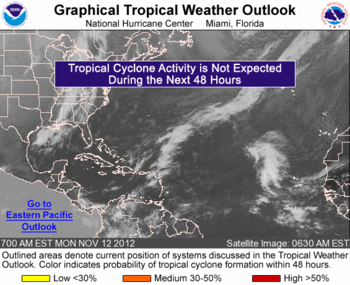Trough (meteorology)

A trough is an elongated (extended) region of relatively low atmospheric pressure, often associated with fronts.[1]

Unlike fronts, there is not a universal symbol for a trough on a weather chart. The weather charts in some countries or regions mark troughs by a line. In the United States, a trough may be marked as a dashed line. In the UK, Hong Kong[2] and Fiji,[3] it is represented by a bold line extended from a low pressure center [4] or between two low pressure centers;[5] in Macau[6] and Australia,[7] it is a dashed line. If they are not marked, troughs may still be identified as an extension of isobars away from a low pressure center.
Sometimes the region between two high pressure centers may assume the character of a trough when there is a detectable wind shift noted at the surface. In the absence of a wind shift, the region is designated a col, akin to a geographic saddle between two mountain peaks.
If a trough forms in the mid-latitudes, a temperature difference between two sides of the trough usually exists in the form of a weather front. A weather front is usually less convective than a trough in the tropics or subtropics (such as a tropical wave). Sometimes collapsed frontal systems will degenerate into troughs.
Convective cells may develop in the vicinity of troughs and give birth to a tropical cyclone. Some tropical or subtropical regions such as the Philippines or south China are greatly affected by convection cells along a trough. In the mid-latitude westerlies, troughs and ridges often alternate, especially when upper-level winds are in a high-amplitude pattern. For a trough in the westerlies, the region just west of the trough axis is typically an area of convergent winds and descending air - and hence high pressure - while the region just east of the trough axis is an area of fast, divergent winds and low pressure. Tropical waves are a type of trough in easterly currents, a cyclonic northward deflection of the trade winds.
Troughs may be at the surface, or aloft, or both under various conditions. Most troughs bring clouds, showers, and a wind shift, particularly following the passage of the trough. This results from convergence or "squeezing" which forces lifting of moist air behind the trough line.
Types of trough
In addition to standard troughs, some may be described further with a qualifying term indicating a specific or a set of characteristics.
Inverted trough
An inverted trough is an atmospheric trough which is oriented opposite to most troughs of the mid-latitudes. Most (but not all) inverted troughs are tropical waves (also commonly called easterly waves).
Most troughs of low pressure in the mid-latitudes of the Northern Hemisphere are characterized by decreasing atmospheric pressure from south to north while inverted troughs are characterized by decreasing pressure from north to south. The situation is opposite in the Southern Hemisphere. Inverted troughs in both hemispheres move to the west from the east, while mid-latitude troughs generally move with the westerlies toward the east.
Lee trough
A "lee trough" is the same thing as a "dynamic trough". According to the AMS Glossary, it is "A pressure trough formed on the lee side of a mountain range in situations where the wind is blowing with a substantial component across the mountain ridge; often seen on United States weather maps east of the Rocky Mountains, and sometimes east of the Appalachians, where it is less pronounced.", and can be formed either as a result of the adiabatic compression of sinking air on the "lee" side of a mountain range, or through cyclogenesis resulting from "the horizontal convergence associated with vertical stretching of air columns passing over the ridge and descending the lee slope."[8][9]
See also
References
- ↑ F. J. Monkhouse. A Dictionary of Geography. London: Edward Arnold (Publishers) Ltd., 1978
- ↑ The Hong Kong Observatory, Weather Map at 08 HKT
- ↑ http://www.met.gov.fj/aifs_prods/0640.gif
- ↑ http://www.hko.gov.hk/wxinfo/currwx/flw_description/image/trough2.png
- ↑ http://www.hko.gov.hk/wxinfo/currwx/flw_description/image/trough3.png
- ↑ Weather Chart
- ↑
- ↑ "American Meteorological Society Glossary - Lee trough". Allen Press Inc. June 2000. Retrieved 2006-10-30. External link in
|publisher=(help) - ↑ Jeff Haby. "What is a Lee-side Trough (Low)?". TheWeatherPrediction.com. Retrieved 2006-10-30. External link in
|publisher=(help)